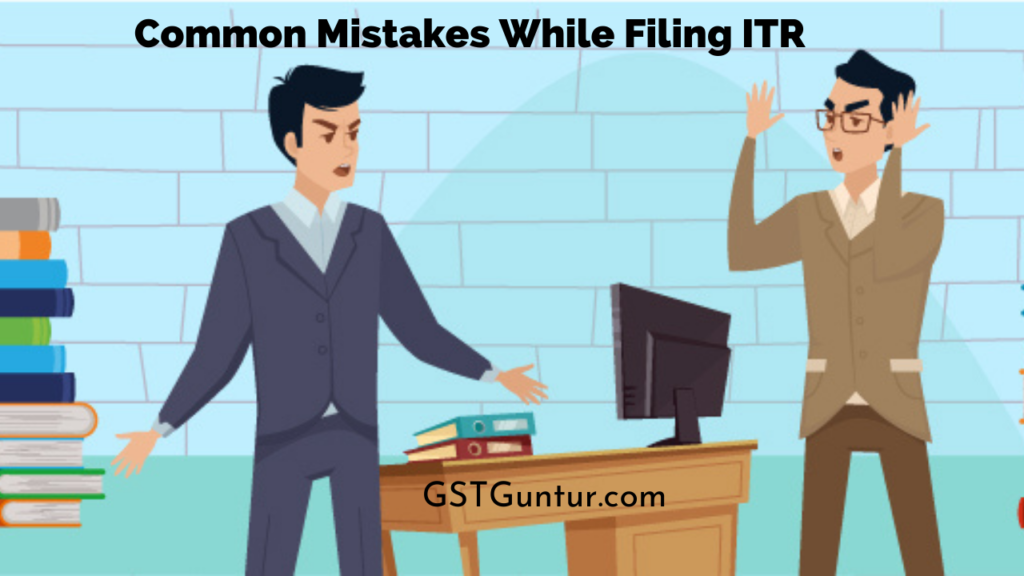Common Mistakes While Filing ITR: Income Tax Return or ITR is a mandatory form that needs to be submitted to the Income Tax Department. It contains information about a person’s finances in a particular financial year such as income and taxes, starting on 1st of April to 31st March of the next year.
Your income can be of various forms such as:
- Income from Salary earned
- Profits and gain from Business and profession
- Income from Properties
- Income for Capital Gains
- Other sources such as dividend, interest on deposits, royalties, lottery etc.
Mistakes while filing the ITR form is usually made due to a lack of knowledge. Incorrect filing of tax returns will lead to a lot of problems. If you are not confident about filing ITR, you should seek professional help.
While filing ITR, a lot of people make mistakes. It is advisable to fill correct information on the form to avoid any future difficulties. These are the most common mistakes people make which you should avoid while filing your ITR.
- Personal Details
- TDS
- Deductions under 80C
- Selecting ITR forms
- Exempt Income
- Incomplete or Incorrect information
- Property Information
- Failure in Sending ITR-V
- Advance or Self Assessment Tax
- How to File ITR Online?
Personal Details
Every year a lot of returns are rejected due to incorrectly filled personal details such as name, bank account number, IFSC code and address, which leads to delay in refunds. While filing your ITR, be sure to fill in your correct personal details and recheck them to avoid delays.
TDS
TDS stands for tax deducted at source and was introduced to make tax deductions at the source of income. Most of the time people are not aware of the TDS deducted from their incomes which is usually in the form of tax deductions from interest accrued to them in the savings account or fixed deposit interest. You can review your TDS deductions from Form 26AS. Also, if the tax deductions made by your employer are not mentioned correctly, the amount will not reflect in form 26AS. Take timely action to rectify the same.
Deductions under 80C
A common mistake people make is that they claim deductions under the wrong heads leading to their rejection, which also leads to tax liability. Employee contribution to EPF is not be claimed under Section 80C benefits. Also, only the principal repaid on housing loans is mentioned under Section 80C.
Selecting ITR forms
There are a total of seven ITR forms: ITR-1, ITR-2, ITR-3, ITR-4, ITR-5, ITR-6 and ITR-7. The applicability of the form depends upon the nature and amount of income and taxpayer. Selecting an incorrect ITR form that is not applicable in their case leads to wrongly filed Income tax return forms.
Exempt Income
Information regarding the PPF interest, dividends, long term capital gain from equities and maturity proceeds of policies need to be mentioned in the separate annexure of the ITR under Exempted Income. Failure to do this will result in unnecessary income tax queries later. Interest income under savings account is also not taxable and therefore it has to be mentioned under the “Income from other sources” to claim exemption.
Incomplete or Incorrect information
Information about certain income which is left erroneously need to be mentioned in the ITR form. These are interest from bank FD, income from investments made in the name of family members, spouse or children and income from the employer.
Property Information
As per the IT Act of 1961, only one property can be claimed as self-occupied and the other property is taxed at realisable municipal rates after deducting 30% for tax and repairs. All the properties are therefore to be mentioned correctly in the ITR form.
Failure in Sending ITR-V
If the ITR is filed without a digital signature or Aadhar verification, it is mandatory to send a signed copy of the ITR-V to CPC Bangalore. If you fail to submit the ITR-V to CPC within 120 days of filing the ITR form, it will be treated as null and void.
Advance or Self Assessment Tax
For income sources where TDS is not applicable, individuals need to calculate the tax liability and pay advance tax or self-assessment tax. It is to be done before 31st March of the financial year, failure to do so will attract 1% penalty tax.
How to File ITR Online?
ITR-1 and ITR-4 can be filed online by entering the data directly online at the e-filing portal. Follow the steps given below:
Go to the official website of the Income Tax e-filing portal.
- Login using User ID and password.
- Click on the “e-File” menu button and open the Income-tax return link.
- Select assessment year and ITR form number as applicable.
- Select filing type as “original/revised return”.
- Select submission mode as “Prepare and Submit online” and click on Continue.
- Read all the instructions carefully and fill all the applicable and mandatory fields of the online ITR form.
- Click on “Preview and Submit” to verify all details and click on “Submit” to file ITR.
- Verify using EVC/OTP.
